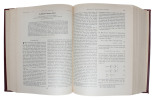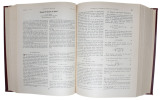1 books for « bethe h a j r ... »Edit
"BETHE, H. A. (+) J. R. OPPENHEIMER (+) G. M. VOLKOFF (+) RICHARD TOLMAN.
Reference : 46901
(1939)
Energy Production in Stars (+) On Massive Neutron Cores (+) Neutron Stars and the Tolman-Oppenheimer-Volkov Limit. - [HANS BETHE'S NOBEL PRIZE WINNING PAPER AND GENERAL RELATIVISTIC THEORY OF STELLAR STRUCTURE]
[Lancaster], American Institute of Physics, 1939. Royal8vo. Bound in contemporary full red cloth with gilt lettering to spine. Entire volume of ""The Physical Review"", Volume 55, Second Series, January 1 - June 15, 1939. ""Development Department"" in small gilt lettering to lower part of spine. A very fine and clean copy. [Bethe:] Pp. 434-456. [Oppenheimer & Volkoff:] Pp. 374-381. [Entire volume: 1300 pp.].
First printing of ""ENERGY PRODUCTION IN STARS"", Hans Bethe's seminal Nobel Prize winning paper on neucleosynthesis. It was the first time an astrophysical subject was recognized by the Nobel Committee. Bethe's work on nuclear reactions led him to discover the reactions that supply the energy in stars. In this paper, Bethe shows that ""the most important source of energy in ordinary stars is the reactions of carbon and nitrogen with protons"" (Bethe, Energy Production in Stars). Bethe began by analyzing the different possibilities for reactions by which hydrogen is fused into helium. He showed two processes to be the sources of energy generation capable of keeping stars hot. The first, the proton-proton chain, is the dominant energy source in stars with masses up to about the mass of the Sun. The second, the carbon-nitrogen-oxygen cycle, is the most important in more massive stars. ""ON MASSIVE NEUTRON CORES"" and NEUTRON STARS AND THE TOLMAN-OPPENHEIMER-VOLKOV LIMIT, two landmark papers which ""for the first time laid a general relativistic theory of stellar structure"" (Pais, Subtle is the Lord), thereby proving Einstein wrong in his conclusion that no star could collapse indefinitely.In the paper they addressed the question that Landau's paper, and also Oppenheimer and Serber's, had failed to consider: what is the maximum mass for stable neutron-star? This paper applied Tolman's method to calculate the gravitational equilibrium of a neutron star and predict the conditions under which it will continue collapsing into a black hole (the Tolman-Oppenheimer-Volkov Limit). The issue contain several other papers of interest: 1. Tolman, Richard. ""Static Solutions of Einstein's Field Equations for Spheres of Fluid"" - This paper developed a method for applying Einstein's field equations to static spheres of fluid in such a manner as to facilitate the development of exact solutions using known analytic functions)"" Jenkins and Segre's ""Quadratic Zeeman Effect"" and ""Zeeman Effect of the Forbidden Lines of Potassium"" .2. Gamow & Teller. ""On the Origin of Great Nebulae"". 3. Seaborg & Segre. ""Nuclear Isomerism in Element 43"" 4. Gentner & Segre. ""Appendix on the Calibration of the Ionization Chamber"". 5. Bethe. ""On the Absence of Polarization in Electron Scattering"" & ""Meson Theory of Nuclear Forces.""
 Write to the booksellers
Write to the booksellers




